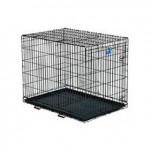10 Tips For Your New Puppy
Willow‘s puppies all went home today with their new forever families. Here are tips for all families that bring home a new puppy:
 Limit the number of rooms the puppy/dog has access to for the first week or so.
Limit the number of rooms the puppy/dog has access to for the first week or so.- Limit the amount of “attention” you give the new member of your family for the first few days…let them get acclimated a bit.
- Place the crate in a bedroom for the first few nights or sleep next to the crate. Remember, all the puppies slept lumped together, spending the night alone will really be scary and having you nearby will greatly help.
- Unless you want a dog that whines in her crate, do not let her out when she is crying/whining/pawing or barking. Wait until she quiets and then let her out. To avoid this, set an alarm for every 3 or 4 hours that first night and wake her up to take her potty. Soon you will be able to cut out those middle of the night potty breaks but if you do this for that first few nights (first week?) it will really pay off. The alternative, letting the dog wake you up can lead to reinforcing whining and barking in the crate. We don’t want that!
 Take your new family member to the same spot in the yard every time he transitions to a new activity (or every hour or two) and tell him “go potty” or some such command. If nothing happens in a few minutes, come back inside.
Take your new family member to the same spot in the yard every time he transitions to a new activity (or every hour or two) and tell him “go potty” or some such command. If nothing happens in a few minutes, come back inside.- Watch for nervous behavior, circling and sniffing the ground, whining – these are cues that your puppy needs to poop.
- You have 3 seconds to reward or correct a behavior! That’s it! So, unless you catch the puppy in the act of peeing, scolding him will only make him afraid of you. If you miss it, let it go and commit to being more attentive in the future.
- Your puppy won’t need a real walk until they are about 4 months of age but do get them used to their leash and collar by putting them on and walking around the yard and house.
- Remember: these guys (Willow included) are like blank slates…they will learn what you teach them or let them do regularly. Be mindful not to condition them to expect behavior that you won’t want a full grown dog to do. A good example, letting them pull you to the door. As anxious as you are to get the out to potty, try to keep good leash manners in front of your mind. Walk to the door with the dog/pup at you side or behind you. Go out the door first, then the pup/dog. Once outside, give a command word as you walk to your potty spot and then let them have full reign of the leash. Otherwise, you are teaching a dog to pull on leash while you are house training it!
 Remember to love them up good but don’t “cut them slack” – keep in mind the behavior you want and reinforce it (with cuddles, praise and treats) and ignore or correct (NOT PUNISH – just make a disapproving sound – I like AH!) behavior you don’t want. They will appreciate the clarity.
Remember to love them up good but don’t “cut them slack” – keep in mind the behavior you want and reinforce it (with cuddles, praise and treats) and ignore or correct (NOT PUNISH – just make a disapproving sound – I like AH!) behavior you don’t want. They will appreciate the clarity.
Cherish your new family member!
Crating Your Dog
 Crates are not bad as some people say – they replicate the idea of a den which dogs naturally dig in the wild. However, no den that they dig includes a door they can’t open. Don’t believe people who say that dogs “love” their crates. No animal likes to be confined against its will. But many dogs learn to tolerate their crates and will go in willingly when asked. Some even go to them when they are tired on their own. But when we shut that door we take away their freedom and they know it. They comply because that is what makes them the amazing creatures they are – they trust us implicitly.
Crates are not bad as some people say – they replicate the idea of a den which dogs naturally dig in the wild. However, no den that they dig includes a door they can’t open. Don’t believe people who say that dogs “love” their crates. No animal likes to be confined against its will. But many dogs learn to tolerate their crates and will go in willingly when asked. Some even go to them when they are tired on their own. But when we shut that door we take away their freedom and they know it. They comply because that is what makes them the amazing creatures they are – they trust us implicitly.




